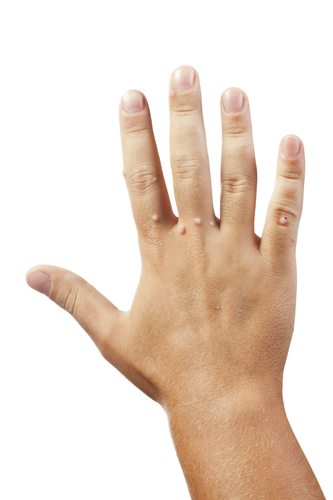You’ve probably heard the old wives’ tale that touching frogs and toads causes warts. As a child, you may have been told to avoid amphibians based on this silly myth, perhaps assuming it was true due to the bumpy skin of some frogs and toads. In actuality, if you want to learn how warts form, you need to focus on the human papillomavirus (HPV). Warts, whether white, brown, pink, or flesh colored, are caused by viruses. They vary in size, and they can appear in clusters or alone. To learn more about these unpleasant growths’ formation, prevention, and treatment, please scroll down.
How Warts Form
Typically, the human papillomavirus (HPV) will infect the top layer of the skin by entering through broken skin (like a small scrape, hangnail, or a cut from shaving). Even a minuscule break in the top layer of the skin can allow HPV to penetrate the skin’s barrier. Once inside, the virus causes a wart to form.
Unfortunately, warts can easily be spread from person to person. If you have a wart, you can infect another person through skin-to-skin contact (such as shaking hands) or by sharing towels, razors, or other personal items. In fact, you can even infect another part of your own body through contact with the wart.
It can be difficult to pinpoint the exact time and place of exposure to HPV, since warts take quite a while to grow large enough to be seen with the naked eye. In addition, some people are far more likely to develop warts than others, perhaps due to differences in the immune system. Children, for example, are more likely to have warts than adults.
Preventing Warts
Knowing exactly how warts form is crucial to prevention. Maintaining proper hygiene is the best place to start. Always make sure that cuts and scrapes are treated properly (bandage as needed) in order to prevent HPV from entering through these vulnerable areas. Keep your fingernails neat and trimmed to avoid hangnails. Wash your hands frequently, and don’t share personal items with people who have warts. By adopting solid hygiene practices, you can greatly decrease your risk of developing these unsightly appendages.
Treating Warts
Although warts are usually harmless and disappear over time, some warts are particularly painful or bothersome. If you would like to remove a troubling wart, you can try at-home treatments that utilize salicylic acid (found at most mass merchandisers and drugstores). Other people swear by duct tape, which researchers say may work by stimulating the patient’s immune system. For more advanced or stubborn warts, consult with a skincare professional who can prescribe stronger medications or recommend minor outpatient procedures (like laser surgery).
Speaking of which, if you’re in need of wart removal – or treatment for any other skin problem – contact DermaHealth Laser & Skin Care Clinic. At our facilities, we can diagnosis your condition, remove your wart, and advise you on any other skin concerns. Simply give us a call at 417-447-7777 or schedule a free consultation online. We look forward to hearing from you!







